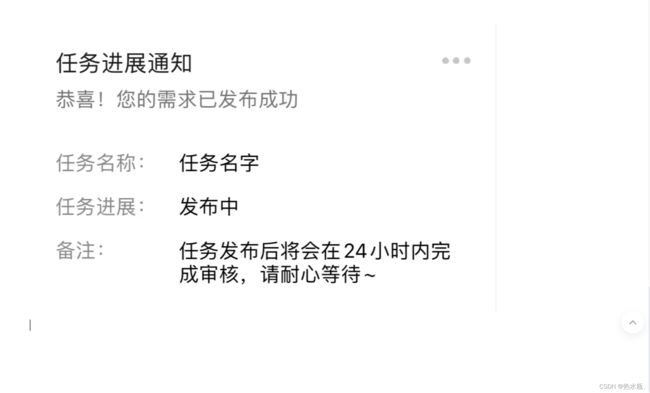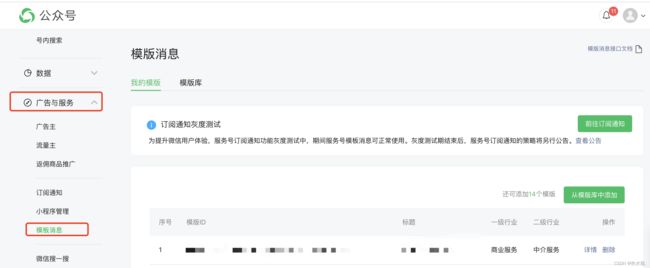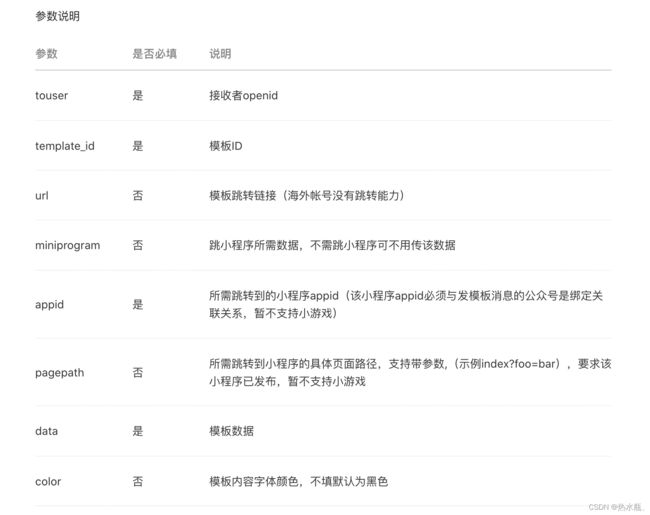微信公众号发送模版消息 Java实现
微信公众号发送模版消息
背景:
当用户发布任务的时候,公众号会自动推送消息通知。例如我们都熟悉的场景:微信支付的时候,公众号会推送支付成功消息。

申请模版:
模版消息,顾名思义,就是有模版的消息,那么要模版干嘛呢?模版是从哪来呢?
发送消息需要有固定的格式,我们可以在微信公众号平台上配置模版。
微信公众号平台–>广告与服务–>模版消息–>我的模版
「我的模版」列表里的是已经申请的模版,如果里面的模版格式都不符合自己业务,可以到模版库里找,然后添加到「我的模版」。也可以按照自己的需求申请新的模版,一般第二个工作日会审核通过。
打开模版详情,查看模版的格式,下图左边红框是消息最终展示的效果,
右边红框是需要传的参数。

有了模版之后,模版ID就是我们要放进代码里的,把模版ID复制出来。
发送模版消息接口文档:
消息模版准备好之后,暂时不要写代码奥,查看微信开发文档,看看发送模版都需要哪些参数。
微信开发文档–>基础消息能力–>模版消息接口–「发送模版消息」
https://developers.weixin.qq.com/doc/offiaccount/Message_Management/Template_Message_Interface.html

微信开发文档参数介绍
发送模版消息
…
http请求方式: POST 请求地址: https://api.weixin.qq.com/cgi-bin/message/template/send?access_token=ACCESS_TOKEN
…
注:
url和miniprogram都是非必填字段,若都不传则模板无跳转;若都传,会优先跳转至小程序。开发者可根据实际需要选择其中一种跳转方式即可。当用户的微信客户端版本不支持跳小程序时,将会跳转至url。
…
返回码说明:
在调用模板消息接口后,会返回JSON数据包。
返回JSON数据包示例如下
{
“errcode”:0,
“errmsg”:“ok”,
“msgid”:200228332
}
发送模版所需参数:
模版ID和openId是必须有的,剩下的就是和自己业务有关了。
上面的内容都搞定之后,就可以开始撸代码了
发送模版微信返回Dto
@Data
public class TemplateMsgResultDto extends ResultState {
/**
* 消息id(发送模板消息)
*/
private String msgid;
}
发送模版微信返回状态
@Data
public class ResultState implements Serializable {
/**
* 状态码
*/
private int errcode;
/**
* 信息
*/
private String errmsg;
}
微信模版消息请求参数实体类
@Data
public class WxTemplateMsg {
/**
* 接收者openId
*/
private String touser;
/**
* 模板ID
*/
private String template_id;
/**
* 模板跳转链接
*/
private String url;
/**
* 消息data
*/
private TreeMap<String, TreeMap<String, String>> data;
/**
* 参数
*
* @param value 值
* @param color 颜色
* @return params
*/
public static TreeMap<String, String> item(String value, String color) {
TreeMap<String, String> params = new TreeMap<String, String>();
params.put("value", value);
params.put("color", color);
return params;
}
}
Java封装模版信息代码
public TemplateMsgResultDto noticeTemplate(TemplateMsgVo templateMsgVo) {
// 模版ID
String templateId="XXX";
TreeMap<String, TreeMap<String, String>> params = new TreeMap<>();
//根据具体模板参数组装
params.put("first", WxTemplateMsg.item("恭喜!您的需求已发布成功", "#000000"));
params.put("keyword1", WxTemplateMsg.item(templateMsgVo.getTaskName(), "#000000"));
params.put("keyword2", WxTemplateMsg.item("需求已发布", "#000000"));
params.put("remark", WxTemplateMsg.item("请耐心等待审核", "#000000"));
WxTemplateMsg wxTemplateMsg = new WxTemplateMsg();
// 模版ID
wxTemplateMsg.setTemplate_id(templateId);
// openId
wxTemplateMsg.setTouser(templateMsgVo.getOpenId());
// 关键字赋值
wxTemplateMsg.setData(params);
String data = JsonUtils.ObjectToString(wxTemplateMsg);
return handleSendMsgLog(data);
}
发送模版代码
private TemplateMsgResultDto handleSendMsgLog(String data) {
TemplateMsgResultDto resultDto = new TemplateMsgResultDto();
try {
resultDto = sendTemplateMsg(data);
} catch (Exception exception) {
log.error("发送模版失败", exception);
}
// TODO 可以记录一下发送记录的日志
return resultDto;
}
public TemplateMsgResultDto sendTemplateMsg(String data) throws Exception {
// 获取token
String accessToken = getAccessToken();
// 发送消息
HttpResult httpResult = HttpUtils.stringPostJson(ConstantsPath.SEND_MESSAGE_TEMPLATE_URL + accessToken, data);
return IMJsonUtils.getObject(httpResult.getBody(), TemplateMsgResultDto.class);
}
/**
* 获取全局token
*/
public String getAccessToken() {
String key = ConstantsRedisKey.ADV_WX_ACCESS_TOKEN;
// 从redis缓存中获取token
if (redisCacheManager.get(key) != null) {
return (String) redisCacheManager.get(key);
}
// 获取access_token
String url = String.format(ConstantsPath.WX_ACCESS_TOKEN_URL, appid, secret);
ResponseEntity<String> result = restTemplate.getForEntity(url, String.class);
if (result.getStatusCode() == HttpStatus.OK) {
JSONObject jsonObject = JSON.parseObject(result.getBody());
String accessToken = jsonObject.getString("access_token");
// Long expires_in = jsonObject.getLong("expires_in");
redisCacheManager.set(key, accessToken, 1800);
return accessToken;
}
return null;
}
微信地址常量类
public class ConstantsPath {
/**
* 微信公众号获取全局token
*/
public static final String WX_ACCESS_TOKEN_URL = "https://api.weixin.qq.com/cgi-bin/token?grant_type=client_credential&appid=%s&secret=%s";
/**
* 微信发送模版消息
*/
public static final String SEND_MESSAGE_TEMPLATE_URL = "https://api.weixin.qq.com/cgi-bin/message/template/send?access_token=";
}
Json工具类
package com.demo.advertiser.common.utils;
import com.fasterxml.jackson.databind.DeserializationFeature;
import com.fasterxml.jackson.databind.JavaType;
import com.fasterxml.jackson.databind.ObjectMapper;
import lombok.extern.slf4j.Slf4j;
import org.apache.commons.lang3.StringUtils;
import org.springframework.cglib.beans.BeanMap;
import java.beans.BeanInfo;
import java.beans.IntrospectionException;
import java.beans.Introspector;
import java.beans.PropertyDescriptor;
import java.lang.reflect.InvocationTargetException;
import java.lang.reflect.Method;
import java.text.SimpleDateFormat;
import java.util.ArrayList;
import java.util.HashMap;
import java.util.List;
import java.util.Map;
@Slf4j
public class JsonUtils {
private static ObjectMapper json;
static {
json = new ObjectMapper();
json.setDateFormat(new SimpleDateFormat("yyyy-MM-dd HH:mm:ss"));
json.configure(DeserializationFeature.FAIL_ON_UNKNOWN_PROPERTIES, false);
}
/**
* 序列化为JSON字符串
*/
public static String ObjectToString(Object object) {
try {
return (json.writeValueAsString(object));
} catch (Exception e) {
log.error("序列化为JSON字符串出错",e);
}
return null;
}
public static <T> T getObject(String jsonString, Class<T> clazz) {
if (StringUtils.isEmpty(jsonString))
return null;
try {
return json.readValue(jsonString, clazz);
} catch (Exception e) {
log.error("将JSON字符串转化为Map出错",e);
return null;
}
}
}
Http工具类
package com.demo.advertiser.common.utils;
import com.google.common.base.Splitter;
import com.demo.advertiser.common.utils.component.HttpResult;
import lombok.extern.slf4j.Slf4j;
import org.apache.commons.lang.StringEscapeUtils;
import org.apache.commons.lang3.StringUtils;
import org.apache.http.HttpEntity;
import org.apache.http.NameValuePair;
import org.apache.http.client.config.RequestConfig;
import org.apache.http.client.entity.UrlEncodedFormEntity;
import org.apache.http.client.methods.CloseableHttpResponse;
import org.apache.http.client.methods.HttpGet;
import org.apache.http.client.methods.HttpPost;
import org.apache.http.entity.ContentType;
import org.apache.http.entity.StringEntity;
import org.apache.http.entity.mime.MultipartEntityBuilder;
import org.apache.http.entity.mime.content.FileBody;
import org.apache.http.entity.mime.content.StringBody;
import org.apache.http.impl.client.CloseableHttpClient;
import org.apache.http.impl.client.HttpClientBuilder;
import org.apache.http.impl.client.LaxRedirectStrategy;
import org.apache.http.message.BasicNameValuePair;
import org.apache.http.util.EntityUtils;
import org.springframework.stereotype.Component;
import javax.servlet.http.HttpServletRequest;
import javax.servlet.http.HttpServletResponse;
import java.io.*;
import java.net.URI;
import java.net.URL;
import java.net.URLDecoder;
import java.nio.file.Files;
import java.nio.file.Path;
import java.nio.file.Paths;
import java.util.ArrayList;
import java.util.HashMap;
import java.util.List;
import java.util.Map;
@Component
@Slf4j
public class HttpUtils {
private static String sourcePath;
public static HttpResult stringPostJson(String path, String content) throws Exception{
return stringPost(path, null, content, "utf-8", "utf-8", "application/json");
}
public static HttpResult stringPost(String path, Map<String,String> headerMap, String content, String contentencode, String encode, String contentType) throws Exception{
StringEntity entity = new StringEntity(content, contentencode);
entity.setContentType(contentType);
return post(path, headerMap, entity, encode);
}
private static HttpResult post(String path, Map<String,String> headerMap, HttpEntity entity, String encode){
HttpResult httpResult = new HttpResult();
CloseableHttpClient httpClient = null;
CloseableHttpResponse response = null;
try{
HttpPost httpPost = new HttpPost(getURI(path));
LaxRedirectStrategy redirectStrategy = new LaxRedirectStrategy();
httpClient = HttpClientBuilder.create().setRedirectStrategy(redirectStrategy).build();
RequestConfig requestConfig = RequestConfig.custom()
.setSocketTimeout(120000)
.setConnectTimeout(120000)
.setConnectionRequestTimeout(120000)
.setCircularRedirectsAllowed(true)
.setRedirectsEnabled(true)
.setMaxRedirects(5)
.build();
httpPost.setConfig(requestConfig);
httpPost.setHeader("User-Agent", header);
if(headerMap != null && headerMap.size() > 0){
for(String name:headerMap.keySet()) {
httpPost.addHeader(name, headerMap.get(name));
}
}
httpPost.setEntity(entity);
response = httpClient.execute(httpPost);
httpResult.setStatus(response.getStatusLine().getStatusCode());
if(httpResult.getStatus() == 200){
HttpEntity resEntity = response.getEntity();
httpResult.setBody(EntityUtils.toString(resEntity, encode));
}
}catch(Exception ex){
log.error("post请求出错", ex);
}finally{
try{
if(response != null){
response.close();
}
if(httpClient != null){
httpClient.close();
}
}catch(Exception ex) {
log.error("post请求关闭资源出错", ex);
}
}
return httpResult;
}
}
package com.demo.advertiser.common.utils.component;
public class HttpResult {
private Integer status = 601;
private String body = "";
public Integer getStatus() {
return status;
}
public void setStatus(Integer status) {
this.status = status;
}
public String getBody() {
return body;
}
public void setBody(String body) {
this.body = body;
}
}

